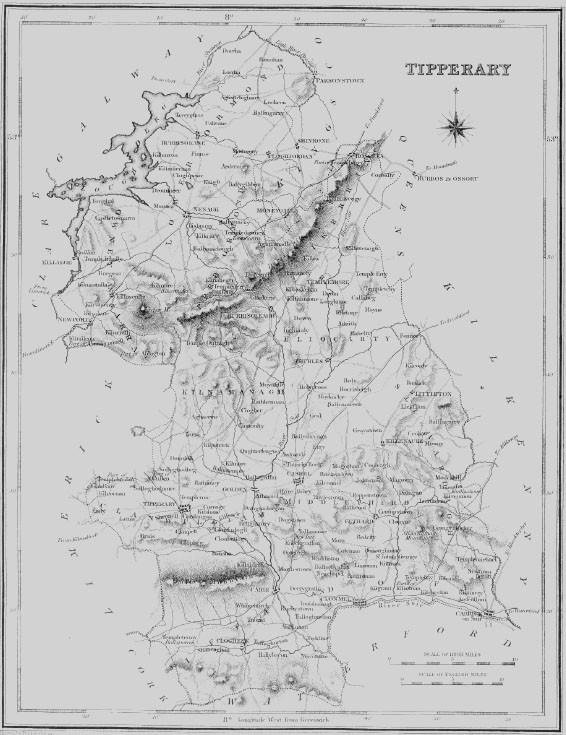| Accompanying Lewis map for Tipperary 
|
| KILMORE |
| KILMORE, a parish, in the barony of KILNEMANAGH, county of TIPPERARY, and province of MUNSTER, 4- miles (W. N. W.) from Cashel ; containing 1029 inhabitants. It comprises 1973 statute acres, as applotted under the tithe act. Kilmore is the residence of Austin Cooper, Esq. ; and Ballywalter, of F. V. Wayland, Esq. It is a chapelry, in the diocese of Cashel, and in the patronage of the Archbishop: the tithes amount to £100. 8. 7-. There is a private school of about 100 children. |
| KILMORE |
| KILMORE, a parish, in the barony of UPPER ORMOND, county of TIPPERARY, and province of MUNSTER, 4 miles (S.) from Nenagh, on the new road to Tipperary ; containing 4717 inhabitants. It comprises 8957 statute acres, includiiig a considerable quantity of mountain and bog ; agriculture is much improved. The mines in this parish are described in the article on Silvermines. Kilboy, the splendid seat of Lord Dunalley, is situated in a well-planted demesne of more than 600 Irish acres, which contains a fine sheet of water and a deer park, and is backed by a range of mountains: the mansion was erected about 60 years since. The other principal seats are Lissen Hall, the property of R. Otway Cave, Esq., and in the occupation of Rowan P. Cashel, Esq. ; Tulla, the property of Major-Gen. Sir Parker Carrol, K. C. B. ; and the glebe-house, the residence of the Very Rev. Gilbert Holmes, Dean of Ardfert. It is a vicarage, in the diocese of Killaloe, episcopally united, in 1801, to the rectories and vicarages of Kilnaneave and Lisbunny, and in the patronage of the Bishop ; the rectory is appropriate to the precentorship of the cathedral of Killaloe, and to the bishop's mensal. The tithes amount to £323. 1. 6-., of which £203. 1. 6-. is payable to the lessee of the bishop, £18. 9. 2-. to the precentor, and £101. 10. 9-. to the vicar ; the tithes of the benefice amount to £909. 4. 7-. The glebe-house was built by a gift of £400 and a loan of £400 from the late Board of First Fruits, in 1812 : there is a glebe of 16a. 2r. 32p. The church, which is in Silvermines, is a very neat edifice, for the erection of which the late Board lent £900, in 1809. In the R. C. divisions the parish is the head of a union or district, called Silvermines, comprising also the parish of Ballynaclough, and containing a chapel at Silvermines and another in Ballynaclough. A school in which about 150 children are taught is supported by Lord Dunalley ; and there are three private schools, in which 100 children are educated. A poor's fund has been instituted, and is chiefly supported by Lord and Lady Dunalley and the incumbent. There are some remains of the old castles of Ballycahill and Tullahedy, also of the ancient castle of Dunalley, which gives the title of Baron to the Prittie family. This castle was besieged by the disbanded soldiery of, Jas. II., who, after investing it for 21 days, effected an entrance by treachery, and threw Mr. Henry Prittie, its proprietor, from the summit of it, but he escaped unhurt. An interesting account of this siege, written by Mr. Prittie, is preserved among the family papers. Here are also the ruins of the old church, with a burial-ground attached. which is the place of sepul ture of the Prittie family. An abbey, of which there are no vestiges, is said to have been founded here in 540. |
| SILVERMINES |
| SILVERMINES, a village, in the parish of KILMORE, barony of UPPER ORMOND, county of TIPPERARY, and province of MUNSTER, 4 miles (S.) from Nenagh ; on the old road from Limerick to Dublin ; containing 791 inhabitants. This place takes its name from some mines which were formerly worked here under the direction of Lord William Russell and Sir Charles Brooke, who held them from the Crown, previously to the parliamentary war in 1641, when the works were destroyed, and the miners, who were chiefly foreigners, were all massacred. The lead ore extracted from these mines was exceedingly pure, and contained a larger proportion of silver than any of the Irish ores, with the exception only of those of Bangor. The mines are now the property of Lord Dunally, whose seat, Kilboy, is within a mile of the village, and from whom they are held by an English company, by whom they have been recently brought into extensive operation. Machinery of every kind requisite to facilitate the various operations has been constructed, smelting-houses erected, and already several hundred men are employed by the company. The village contains 131 houses, several of which are neatly built. Fairs are held on May 1st, June 8th, Sept. 12th, and Oct. 25th, chiefly for farming stock, The parish church of Kilmore, a neat edifice with a spire nearly covered with ivy, ornamented with a beautifully painted window representing Faith, Hope, and Charity, and containing a monument to the late Lady Dunally, is situated in the village ; in which are also a plain neat R. C. chapel, a dispensary, a charitable loan fund, and a poor's fund for the parishes of Kilmore and Dolla. |
|